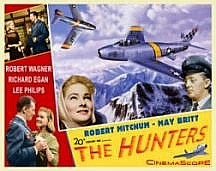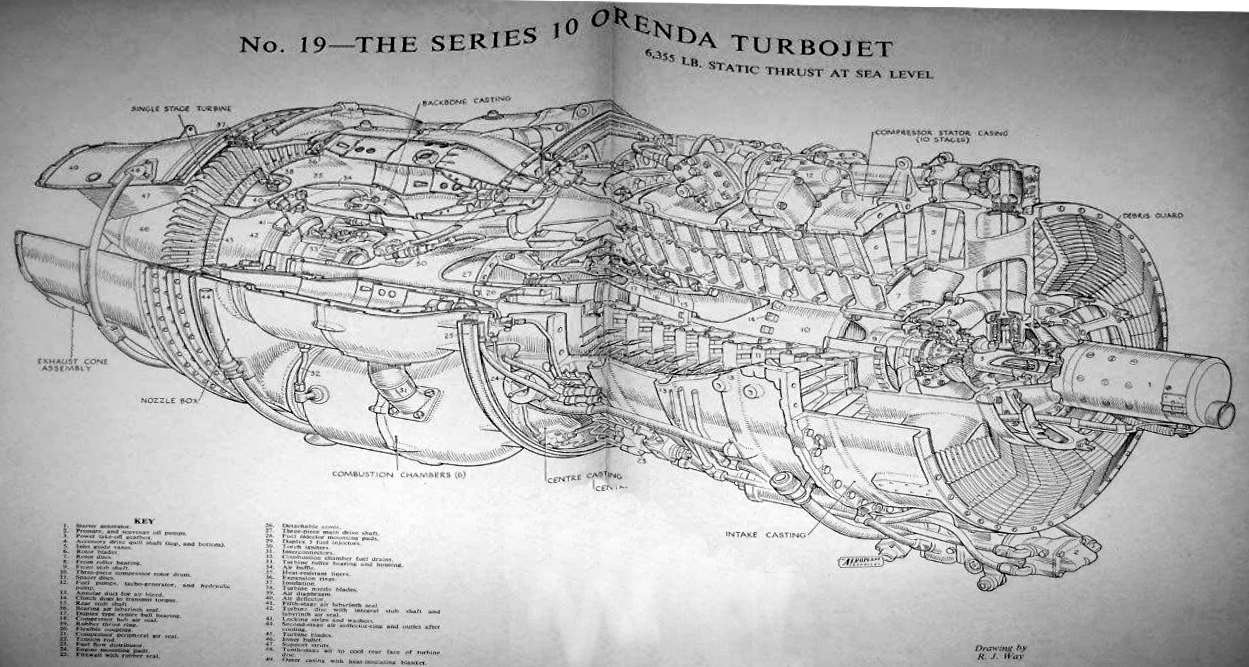|
Col. Francis Gabreski is shown here bagging one of the 6½
MiGs that he added to his total of 24 confirmed victories in Europe during
WWII.
The frosty morning air is shattered by a hunting party of F-86 Sabres
of the U.S. 51st Fighter-Interceptor Wing, led by
Gabby Gabreski, as they
blast off the runway at Kimpo airfield, South Korea.
This
is a highly detailed plastic kit of the F-86 variant with lengthened "6-3"
swept-wings that saw extensive use during the Korean War against the MIG-15.
North American F-86F Sabre, "Beautious Butch,"
flown by America's top scoring Korean War ace,
Captain Joseph M. McConnell, Jr.,
39th FIS, K-13, May 1953.
Korean War aces Major General Federick C. Blesse,
Brigadier General Robinson Risner, Colonel Harold E. Fischer and Colonel Ralph
S. Parr.
Sabre Dog series explores the F-86s of the U.S.
Air National Guard as well as those in foreign service around the world.
Canadair Sabre flown by the German Luftwaffe in
1954
Canadair Sabre flown by
352-victory ace Col. Erich Hartmann
of JG 71 Richthofen, West German Air Force,
during the Cold War 1961
markings including Hartmann's trademark spreading black tulip nose art,
On July 19th, 1953, after his flight of four
F-86s was set upon by 16 MiGs, John Glenn pursued and "flamed" a MiG to score
the second of his three Korean War kills.
the Battle of Carlson's Canyon,
The Life Story of the World's Highest Scoring Ace
Jager. With 352 aerial victories and ten years in a Soviet prison,
Erich
Hartmann survived uprisings, hunger strikes, and forced labor. His will to do
his duty was remarkable - after being released, he was still mentally and
physically fit enough to fly F-86 jet fighters in
the post-World War II German Air Force. This photo album presents the different
stages of his life - a man who wished to become a doctor, but whose fate it was
to become and remain a soldier.
USAF pilot
Lt. Joseph M. McConnell Jr.'s Sabre, "Beautious
Butch II," as he flew it for the 39th Fighter-Interceptor Squadron/51st
Fighter-Interceptor Wing.
The CL-13 (F-86) flown by "Ace of Aces"
Col.
Erich Hartmann leads the first all-jet fighter wing - JG 71 Richthofen, whose
aircraft all sport the spreading black tulip nose art that was Hartmann's
personal emblem throughout World War II - of the West German Air Force on a 1961
mission.
America's Air Force Celebrates 100 Years of Aviation. Hildebrandt.
Assembled by the USAF to celebrate the 100th anniversary of powered flight, this
unique demonstration team pairs military pilots in the latest aircraft with
civilian pilots in classic Warbirds for breathtaking formation flight.
Outstanding air-to-air photography captures F-16 Falcons, F-15 Eagles and A-10
Warthogs in concert with a C-130, B-25, F-86 and others.
Wearing what were perhaps the largest shark's
teeth markings of the Korean War, this F-86F was flown by
Joseph Fields of the
4th Fighter-Interceptor Wing in 1953.
1950s jet fighter. A truly great platform, the
F-86 evolved into an all-weather interceptor, an atomic-capable fighter-bomber,
a carrier-based naval plane, a trainer, and much more. Documented here are the
XP-86 through the "L" variants.
"Beautious Butch," the F-86 flown by America's
top scoring Korean War ace, Captain Joseph M. McConnell.
The 116th Fighter-Interceptor Squadron, which was
the first to be based in Europe with F-86s.
The F-86D Sabre Dog, the military all-weather,
radar-equipped variant of the U.S. Air Force's early Cold War frontline jet
fighter.
Angel Face and the Babes flown by
USAF pilot Col.
Royal Baker - who achieved ace status during the Korean War - of the 336th FIS,
4th FIW
F-86E flown by
U.S. Air Force Ace Capt. Clifford Jolley,
who served with the 335th Fighter-Interceptor Squadron, 4th
Fighter-Interceptor Wing in Korea.
Mitch's Squitch, the F-86 piloted by 51st
Fighter-Interceptor Wing commander Col. John Mitchell, who shot down four MiGs
over Korea but who gained even more fame as the leader of the World War II
mission that shot down Admiral Yamamoto.
The 4th Fighter Interceptor Wing (FIW) was sent
to Korea in December 1950 expressly to face the threat posed by the all-new
MiG-15 fighter that had made its combat debut the previous month. It remained
the sole Sabre wing in-theater for a full year, its pilots tangling with
Russian-flown jets over the Yalu River in "MiG Alley," on a near-daily basis.
Through sheer skill and superior machinery, the 4th FIW prevailed, and the skies
over North Korea remained firmly in U.N. control
John Glenn's Sabre, "MiG Mad Marine.
This beautifully restored F-86 Sabre, one of the
most pristine Korean-era warbirds flying, is painted with the markings of
USMC (then) Maj. John Glenn, Jr.
of the 51st Fighter Interceptor Wing and
flown by pilot Mike Keenum.
Col.
Walker M. "Bud" Mahurin, who added 3½ kills to his World War II tally of
21 while flying in the Korean War.
Mahurin's Honest John markings
from the spring of 1952, when he was Commander of the 4th Fighter Wing;
Featuring the special 1956 "gunnery meet"
markings of a Sabre from the 366th Fighter-Bomber Wing based at
Alexandria AFB, Louisiana,
Painted in the colorful 1956 livery of the
Skyblazers, a USAF demonstration team that performed in Europe from the late
1940s through the late 1950s
The Huff, the F-86 flown by 51st
Fighter-Interceptor Wing pilot Lt. James
Thompson, who chose the colorful paint scheme after downing a MiG-15 with
a dragon painted on its side
Skyblazers poster features the F-86 that the USAF
demonstration team flew in Europe in 1955-56.
Col. Ralph Parr, who earned more than 60
decorations flying over 1,100 hours of combat in World War II, Korea and
Vietnam, this limited edition,
The
conflict in Korea saw F-86 Sabres of the USAF take on MiG-15s of North Korea and
China. Sound training and skillful leadership soon enabled Sabre pilots to
dominate the dogfights. In all, 39 F-86 pilots became aces.
The F-86 Sabre was the western world's premier
fighter aircraft during the early 1950s. Over 800 MiG pilots in Korea discovered
firsthand about the superiority of the F-86. But the real story begins during
the waning years of WWII, when the Luftwaffe's Me 262 dooms the future of
propeller-driven aircraft.
The aircraft were colorful and their crews were
often courageous - but virtually unknown beyond the South American continent.
Based on fifteen years of research, this book traces the use of aircraft in
Latin America from the frail Wright Model Bs, through World War II-era bombers
and fighters, to jet fighters such as the F-86 in border skirmishes, revolutions
and full-scale warfare, including the final aerial engagements between
piston-engine fighters.
Development of
its swept-wing design and the "trick" that the U.S. learned from the German
Me-262 to make the swept wing work!
The F-86H, through the development and
service of this little-known variant, which was initially designed to be a
fighter-bomber version of the classic Sabre day fighter. And though the plane
was overshadowed by the new F-100, the F-86H did serve for many years with the
Air National Guard
Remotely controlled
aircraft drones were proposed in 1901, but later used mostly by the military. In
the 1970s, obsolete F-86s were converted into drones and used in missile
testing. Here are spectacular photos of these tests at Point Mugu, China Lake,
and White Sands Missile Range.
The
F-86 and the Battle for Air Superiority in Korea, Werrell. Combining hardware
and personnel, design and operations, this book focuses on one clear American
victory of the Korean War: the jet fighter battle between the F-86 and the
MiG-15. You'll learn how, despite being outnumbered, the USAF won air
superiority in Korea with an aircraft that was initially inferior to its
opponent; find out why numerous Air Force pilots violated restrictions and
destroyed MiGs over China.
The
all-weather bomber/interceptor has always been over-shadowed by the Korean War
vintage F-86A/E/F series of day fighters. Although unglamorous in comparison,
the "Dog" was responsible for several world speed records |


